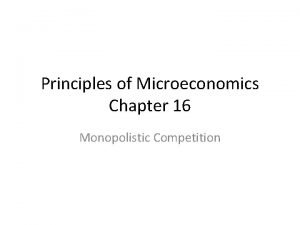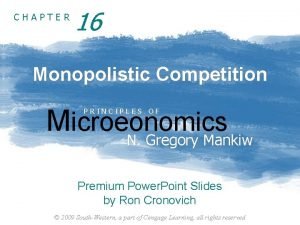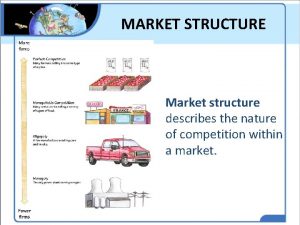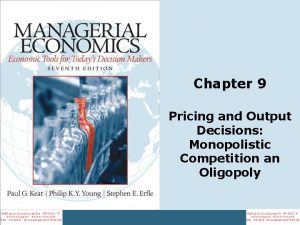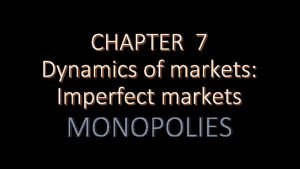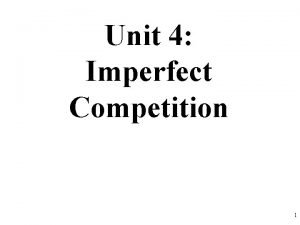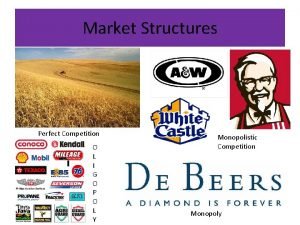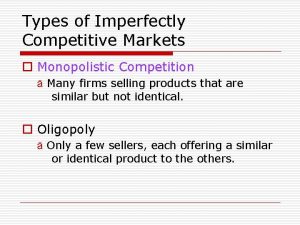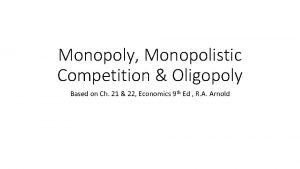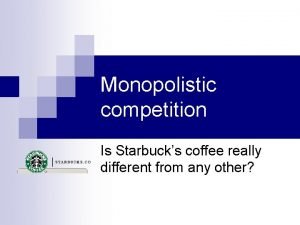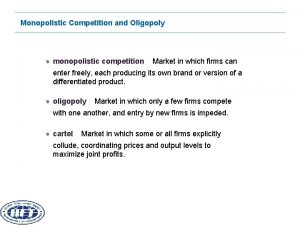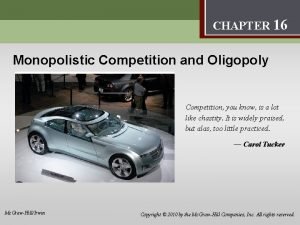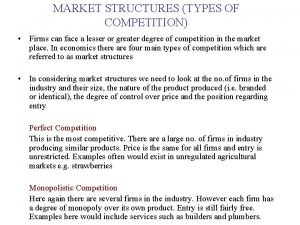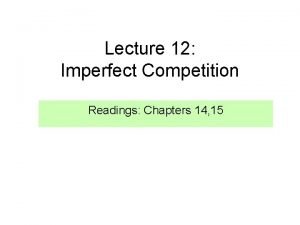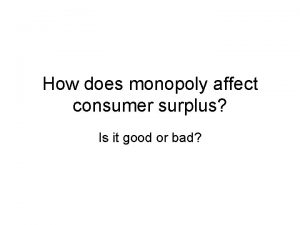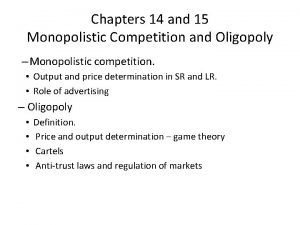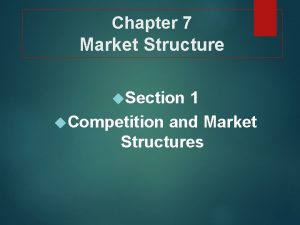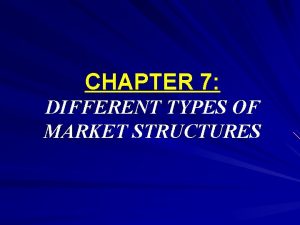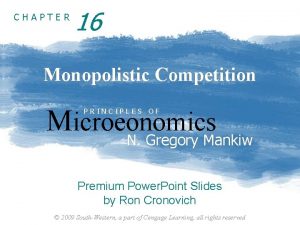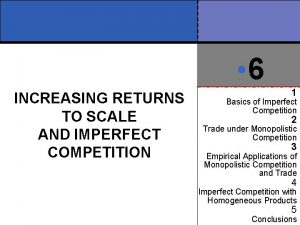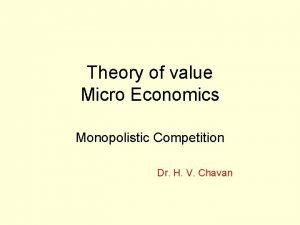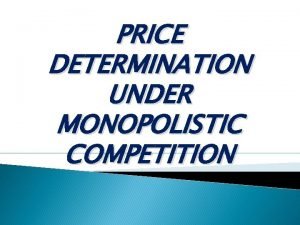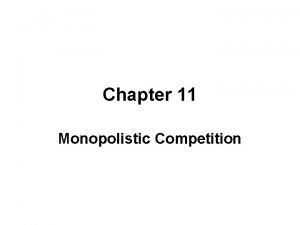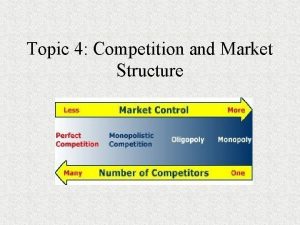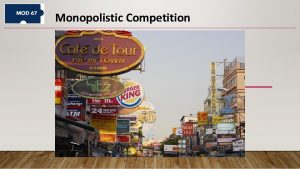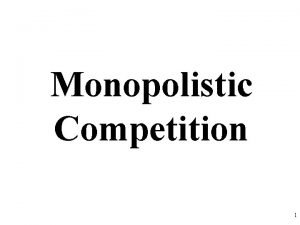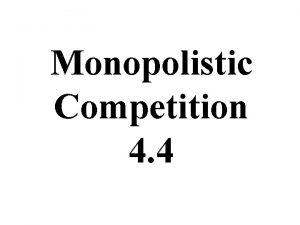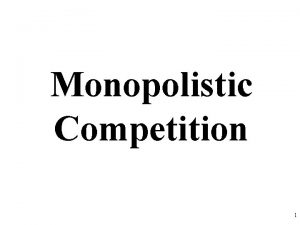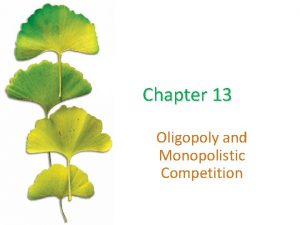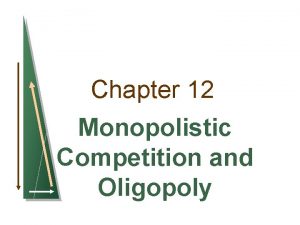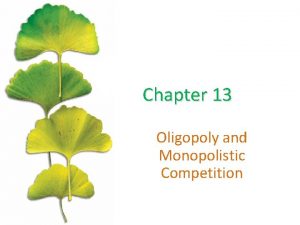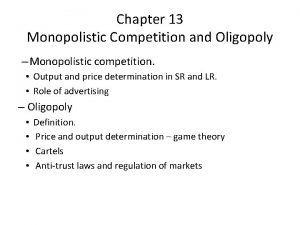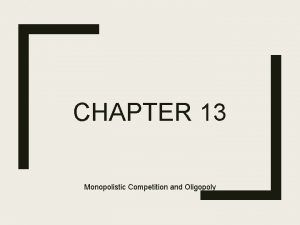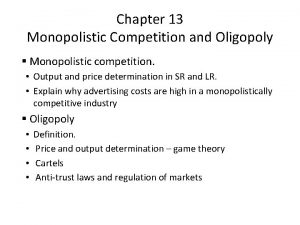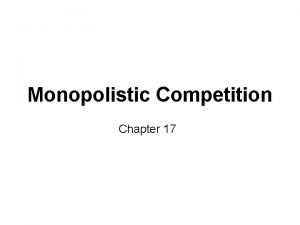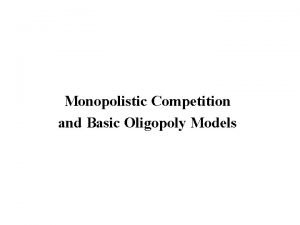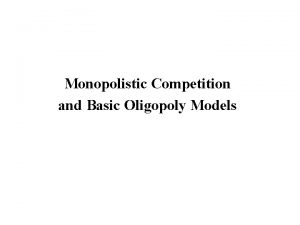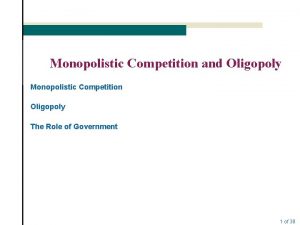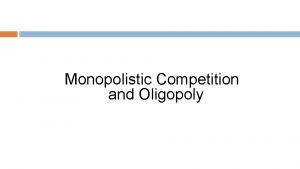Chapter 10 Professor Yuna Chen Monopolistic Competition and




































- Slides: 36

Chapter 10 Professor Yuna Chen Monopolistic Competition and Oligopoly © 2015 Cengage Learning. All Rights Reserved. May not be copied, scanned, or duplicated, in whole or in part, except for use as permitted in a license distributed with a certain product or service or otherwise on a password-protected website for classroom use. 1

Monopolistic Competition 1. Monopolistic competition – How many sellers and buyers? Many sellers and many buyers – How difficult to start up business? Low barriers to entry and exit – Are products from different sellers identical? No. They are slightly different products – differentiated product • A firm that raises prices: lose some customers to rivals – Do sellers have market power? Yes, they have some control over price ‘Price makers’ • Downward sloping demand curve © 2015 Cengage Learning. All Rights Reserved. May not be copied, scanned, or duplicated, in whole or in part, except for use as permitted in a license distributed with a certain product or service or otherwise on a password-protected website for classroom use. 2

Monopolistic Competition 1 a. Product differentiation is generated from – Physical differences • Appearance; quality – Location • Spatial differentiation – Services • Friendly, professional – Product image • Promotion; advertising © 2015 Cengage Learning. All Rights Reserved. May not be copied, scanned, or duplicated, in whole or in part, except for use as permitted in a license distributed with a certain product or service or otherwise on a password-protected website for classroom use. 3

Question 1 • Suppose people believe you are the best babysitter in town. Your neighbor also babysits but people think her service is mediocre. Compare the demand for your service and your neighbor's, which one is more elastic? • Review: if quantity demanded drops more when price increases, the demand is more elastic. • Answer: the demand for your neighbor’s service is more elastic. If you and your neighbor both raise $1/hour, you would lose less customers than your neighbor because you are the best in town. • Conclusion: the more differentiate the product is, the less elastic the demand © 2015 Cengage Learning. All Rights Reserved. May not be copied, scanned, or duplicated, in whole or in part, except for use as permitted in a license distributed with a certain product or service or otherwise on a password-protected website for classroom use. 4

Question 2 • Suppose the number of dog sitters in the spring is 10, and in the summer is 60. Which demand curve for dog sitting is more elastic, the one in the spring or the one in the summer? • Answer: The demand in the summer is more elastic because more people offer dog sitting service. • Conclusion: the more substitutes there are, the more elastic the demand. © 2015 Cengage Learning. All Rights Reserved. May not be copied, scanned, or duplicated, in whole or in part, except for use as permitted in a license distributed with a certain product or service or otherwise on a password-protected website for classroom use. 5

1 b. Short-Run Profit or Loss – Demand curve, D • Slopes downward, more elastic than the monopoly demand due to many substitutes • Demand curve comparison Perfect competition/monopolistic competition/ monopoly – Marginal revenue, MR • Below the demand curve • Slopes downward – Average total cost, ATC – Average variable cost, AVC – Marginal cost, MC © 2015 Cengage Learning. All Rights Reserved. May not be copied, scanned, or duplicated, in whole or in part, except for use as permitted in a license distributed with a certain product or service or otherwise on a password-protected website for classroom use. 6

Short-Run Profit or Loss • Golden Rule to maximize profit: MR=MC A firm in monopolistic competition market maximize profit just like a monopolist. © 2015 Cengage Learning. All Rights Reserved. May not be copied, scanned, or duplicated, in whole or in part, except for use as permitted in a license distributed with a certain product or service or otherwise on a password-protected website for classroom use. 7

Example 1. How to maximize profit Refer to the graph on the right. Step 1. MR = MC at point e. Step 2. Go vertically down to find q, the output level that maximizes profit. Step 3. From q, go vertically up to the demand curve and find b. Step 4. From b, go horizontally to the y axis to find p, the profit maximizing price. Step 5. Total revenue TR = (p)(q) Step 6. Total cost TC = (c)(q) (ATC is c) Step 7. Profit = TR – TC = (p)(q) – (c)(q) This is the blue shaded area. This firm is making profit. © 2015 Cengage Learning. All Rights Reserved. May not be copied, scanned, or duplicated, in whole or in part, except for use as permitted in a license distributed with a certain product or service or otherwise on a password-protected website for classroom use. 8

Answers for Example 2 Refer to the graph on the right. • What is the profit maximizing output? • 100 (because MR = MC) • Which price maximizes profit? • $10 • What is ATC? • $10 (to produce 100) • What is total revenue? • TR = (P)(Q) = ($10)(100) = $1000 • What is total cost? • TC = (ATC)(Q) = ($10)(100) = $1000 • What is the profit? • Profit = TR-TC = $1000 - $1000 = 0 • This firm is breaking even © 2015 Cengage Learning. All Rights Reserved. May not be copied, scanned, or duplicated, in whole or in part, except for use as permitted in a license distributed with a certain product or service or otherwise on a password-protected website for classroom use. 9

Answers for Example 3 Refer to the graph on the right, • What is the profit maximizing output? 400 • Which price maximizes profit? $50 • What is ATC? $60 • What is total revenue? TR = (400)($50) = $20, 000 • What is total cost? TC = ($60)(400) = $24, 000 • What is the profit? Profit = $20, 000 - $24, 000 = -$4, 000 • This firm incurs loss. © 2015 Cengage Learning. All Rights Reserved. May not be copied, scanned, or duplicated, in whole or in part, except for use as permitted in a license distributed with a certain product or service or otherwise on a password-protected website for classroom use. 10

Example 4. Shutdown or stay? • • • Refer to the graph Q= P= TR = TC = Profit = VC = FC = Shutdown or stay? © 2015 Cengage Learning. All Rights Reserved. May not be copied, scanned, or duplicated, in whole or in part, except for use as permitted in a license distributed with a certain product or service or otherwise on a password-protected website for classroom use. 11

1 c. Profit in the Long-Run • If the firm in the industry make economic profit ØNew firms enter the market ØDraw customers away from existing firms ØDemand for each firm decreases ØEconomic profit drops until zero For example, if there are only 5 restaurants in a town and they are all making economic profit. Very soon, new restaurants will keep opening until no one earns economic profit. © 2015 Cengage Learning. All Rights Reserved. May not be copied, scanned, or duplicated, in whole or in part, except for use as permitted in a license distributed with a certain product or service or otherwise on a password-protected website for classroom use. 12

Profit in the Long-Run • If firms in the industry suffer from economic losses ØSome of the firms shut down or exit the market ØTheir customers switch to remaining firms Ø demand for the remaining firms increase Ø Loss declines until zero For example, if there are too many gas stations in town and suffer from losses, some of them close out. The remaining gas stations break even in the long run. © 2015 Cengage Learning. All Rights Reserved. May not be copied, scanned, or duplicated, in whole or in part, except for use as permitted in a license distributed with a certain product or service or otherwise on a password-protected website for classroom use. 13

Exhibit 2 Dollars per unit Long-Run Equilibrium in Monopolistic Competition MC b p a ATC D MR 0 q Quantity period If existing firms earn economic profit in the short run, new firms will enter the industry in the long run. This entry reduces the demand facing each firm. In the long run, each firm’s demand curve shifts leftward until marginal revenue equals marginal cost (point a) and the demand curve is tangent to the average total cost curve (point b). Economic profit is zero at output q. With zero economic profit, no more firms will enter, so the industry is in longrun equilibrium. The same longrun outcome occurs if firms suffer a short-run loss. Firms leave until remaining firms earn just a normal profit. © 2015 Cengage Learning. All Rights Reserved. May not be copied, scanned, or duplicated, in whole or in part, except for use as permitted in a license distributed with a certain product or service or otherwise on a password-protected website for classroom use. 14

Summery In the short run • If p>ATC • Economic profit • If p = ATC • Breaking even • If ATC>p>AVC – Economic loss; stay in production • If p<AVC: – Economic loss; Shut down in short run © 2015 Cengage Learning. All Rights Reserved. May not be copied, scanned, or duplicated, in whole or in part, except for use as permitted in a license distributed with a certain product or service or otherwise on a password-protected website for classroom use. 15

Summary In the long run, • Economic profit = 0 because of the low barriers to entry. • Exit the industry if P < ATC in the long run. • Acts like a monopolist in profit maximization because the demand curve is downward sloping; • Like a perfectly competitive firm, makes zero economic profit in the long run due to easy entry and exit. © 2015 Cengage Learning. All Rights Reserved. May not be copied, scanned, or duplicated, in whole or in part, except for use as permitted in a license distributed with a certain product or service or otherwise on a password-protected website for classroom use. 16

Exhibit 3 Perfect Competition Versus Monopolistic Competition in Long -Run Equilibrium (b) Monopolistic competition Dollars per unit MC ATC p d=MR=AR Dollars per unit (a) Perfect competition MC ATC p’ D MR 0 q Quantity period 0 q’ Quantity period Cost curves are assumed to be the same in each panel. The perfectly competitive firm of panel (a) faces a demand curve that is horizontal at market price p. Long-run equilibrium occurs at output q, where the demand curve is tangent to the average total cost curve at its lowest point. The monopolistically competitive firm of panel (b) is in long-run equilibrium at output q’, where demand is tangent to the average total cost curve. Because the demand curve slopes downward in panel (b), the tangency does not occur at the minimum point of average total cost. Thus, the monopolistically competitive firm produces less output and charges a higher price than does a perfectly competitive firm with the same cost curves. Neither firm earns economic profit in the long run. The firm in monopolistic competition has excess capacity, meaning that it could reduce average cost by increasing its rate of output. © 2015 Cengage Learning. All Rights Reserved. May not be copied, scanned, or duplicated, in whole or in part, except for use as permitted in a license distributed with a certain product or service or otherwise on a password-protected website for classroom use. 17

Comparison Table Perfect competition Monopolistic competition Demand Marginal revenue Profit maximizing rule Product Control over price Profit max. output Profit max price Short run operation Long run profit Long run © 2015 Cengage Learning. All Rights Reserved. May not be copied, scanned, or duplicated, in whole or in part, except for use as permitted in a license distributed with a certain product or service or otherwise on a password-protected website for classroom use. 18

Comparison Table Demand Perfect competition Horizontal Monopolistic competition Downward sloping Marginal revenue The same as demand Below the demand curve Profit maximizing rule MR=MC Product Identical Differentiated Control over price Price taker Price maker Profit max. output More than monopolistic competition firm Less than perfect competition firm Profit max price Market equilibrium price Higher than perfect competition equilibrium price Short run operation Economic profit, breaking even, or loss are possible Long run profit Economic profit = zero Long run Produce at minimum AC Not produce at minimum AC Excess capacity © 2015 Cengage Learning. All Rights Reserved. May not be copied, scanned, or duplicated, in whole or in part, except for use as permitted in a license distributed with a certain product or service or otherwise on a password-protected website for classroom use. 19

2. Introduction to Oligopoly • Oligopoly – A few firms, many buyers – Each behaves interdependently (not independent) • The more similar the products – The greater the interdependence 2 a. Varieties of oligopoly • Undifferentiated oligopoly – Oligopoly that sells a commodity • Differentiated oligopoly – Oligopoly that sells products that are slightly different across suppliers © 2015 Cengage Learning. All Rights Reserved. May not be copied, scanned, or duplicated, in whole or in part, except for use as permitted in a license distributed with a certain product or service or otherwise on a password-protected website for classroom use. 20

Introduction to Oligopoly 2 b. Barriers to entry – Economies of scale – Legal restrictions – Brand names – Control over an essential resource – High cost of entry (High start-up costs; high spending on advertising; high cost on testing and developing new product) – Crowding out the competition (by making many similar products from the same brand) © 2015 Cengage Learning. All Rights Reserved. May not be copied, scanned, or duplicated, in whole or in part, except for use as permitted in a license distributed with a certain product or service or otherwise on a password-protected website for classroom use. 21

Models of Oligopoly • Collusion and cartels • Price leadership • Game theory © 2015 Cengage Learning. All Rights Reserved. May not be copied, scanned, or duplicated, in whole or in part, except for use as permitted in a license distributed with a certain product or service or otherwise on a password-protected website for classroom use. 22

Collusion and Cartels • Collusion – Agreement among firms to increase economic profit by – Dividing the market – Fixing the price • Cartel – Group of firms that agree to coordinate their production and pricing decisions • To reap monopoly profit – Illegal in U. S. – OPEC (12 members) © 2015 Cengage Learning. All Rights Reserved. May not be copied, scanned, or duplicated, in whole or in part, except for use as permitted in a license distributed with a certain product or service or otherwise on a password-protected website for classroom use. 23

Collusion and Cartels • Colluding firms, compared to the noncolluding ones, produce less output, charge higher price, and earn more profit. • Collusion hurts consumers due to charging higher price. Thus collusion and cartels are illegal in the United States © 2015 Cengage Learning. All Rights Reserved. May not be copied, scanned, or duplicated, in whole or in part, except for use as permitted in a license distributed with a certain product or service or otherwise on a password-protected website for classroom use. 24

Collusion and Cartels • Since the cartel acts as if they are just one firm, they maximize profit exactly like a monopolist does. • Cheating – firms in the cartel have high temptation to cheat on the agreement because the firm can earn more profit by breaking the agreement of the fixed price or fixed quantity. © 2015 Cengage Learning. All Rights Reserved. May not be copied, scanned, or duplicated, in whole or in part, except for use as permitted in a license distributed with a certain product or service or otherwise on a password-protected website for classroom use. 25

3 b. Price Leadership • Price leadership – Informal, tacit collusion • Price leader – Sets the price for the industry – Initiate price changes – Followed by the other firms © 2015 Cengage Learning. All Rights Reserved. May not be copied, scanned, or duplicated, in whole or in part, except for use as permitted in a license distributed with a certain product or service or otherwise on a password-protected website for classroom use. 26

Price Leadership • Obstacles – U. S. antitrust laws – Product differentiation – No guarantee others will follow © 2015 Cengage Learning. All Rights Reserved. May not be copied, scanned, or duplicated, in whole or in part, except for use as permitted in a license distributed with a certain product or service or otherwise on a password-protected website for classroom use. 27

3 c. Game Theory • Game theory – Approach that analyzes oligopolistic behavior – Series of strategic moves and countermoves by rival firms – Focus: each player’s incentives to cooperate or compete © 2015 Cengage Learning. All Rights Reserved. May not be copied, scanned, or duplicated, in whole or in part, except for use as permitted in a license distributed with a certain product or service or otherwise on a password-protected website for classroom use. 28

Game Theory • Prisoner’s dilemma – Game that shows why players have difficulty cooperating – Even though they would benefit from cooperation • Strategy – Operational plan pursued by a player © 2015 Cengage Learning. All Rights Reserved. May not be copied, scanned, or duplicated, in whole or in part, except for use as permitted in a license distributed with a certain product or service or otherwise on a password-protected website for classroom use. 29

Game Theory • Payoff matrix – Table listing the payoffs • that each player can expect from each move • based on the actions of the other player • Dominant-strategy equilibrium – Outcome achieved when each player’s choice does not depend on what the other player does © 2015 Cengage Learning. All Rights Reserved. May not be copied, scanned, or duplicated, in whole or in part, except for use as permitted in a license distributed with a certain product or service or otherwise on a password-protected website for classroom use. 30

Example 5 Prisoner’s Dilemma Rocky Ginger Not confess Confess Ginger: 2 year Rocky: 2 year Ginger: 5 years Rocky: 1 year Ginger: 3 years Rocky: 5 years Rocky: 3 years © 2015 Cengage Learning. All Rights Reserved. May not be copied, scanned, or duplicated, in whole or in part, except for use as permitted in a license distributed with a certain product or service or otherwise on a password-protected website for classroom use. 31

Game Theory • Nash equilibrium – A player chooses the best strategy given the strategies chosen by others (In the Prisoner’s Dilemma example, Nash equilibrium is 3 years for Rocky and 3 years for Ginger) – No participant can improve his or her outcome by changing strategies • Even after learning of the strategies selected by other participants © 2015 Cengage Learning. All Rights Reserved. May not be copied, scanned, or duplicated, in whole or in part, except for use as permitted in a license distributed with a certain product or service or otherwise on a password-protected website for classroom use. 32

Example 6 Two firms game One-shot game • Game is played just once • Firms maximize self-benefit regardless of the others. Firm A Firm B Low price High price Low price A: $20, 000 B: $10, 000 A: - $5, 000 B: $80, 000 High price A: $100, 000 B: - $2, 000 A: $70, 000 B: $60, 000 © 2015 Cengage Learning. All Rights Reserved. May not be copied, scanned, or duplicated, in whole or in part, except for use as permitted in a license distributed with a certain product or service or otherwise on a password-protected website for classroom use. 33

Game Theory – Repeated games • Cooperation between firms can increase profit for both firms • Tit-for-tat strategy • Collusion is illegal © 2015 Cengage Learning. All Rights Reserved. May not be copied, scanned, or duplicated, in whole or in part, except for use as permitted in a license distributed with a certain product or service or otherwise on a password-protected website for classroom use. 34

Comparison • oligopoly charges higher price and lower output compared to perfect competition • - oligopoly makes higher profits in the long run © 2015 Cengage Learning. All Rights Reserved. May not be copied, scanned, or duplicated, in whole or in part, except for use as permitted in a license distributed with a certain product or service or otherwise on a password-protected website for classroom use. 35

Examples • This video clip gives a few examples of game theory. • https: //www. youtube. com/watch? v=t 9 Lo 2 fgx. WHw © 2015 Cengage Learning. All Rights Reserved. May not be copied, scanned, or duplicated, in whole or in part, except for use as permitted in a license distributed with a certain product or service or otherwise on a password-protected website for classroom use. 36
 Characteristic of monopoly
Characteristic of monopoly Monopoly vs monopolistic competition
Monopoly vs monopolistic competition Market structure venn diagram
Market structure venn diagram Perfect competition vs monopolistic competition
Perfect competition vs monopolistic competition Chapter 7 section 3 monopolistic competition and oligopoly
Chapter 7 section 3 monopolistic competition and oligopoly Chapter 16 monopolistic competition
Chapter 16 monopolistic competition Conclusion of monopolistic competition
Conclusion of monopolistic competition Chapter 16 monopolistic competition
Chapter 16 monopolistic competition Yuna wong war games
Yuna wong war games Yuna.qq
Yuna.qq Difference between monopoly and monopolistic competition
Difference between monopoly and monopolistic competition Pros and cons of oligopoly
Pros and cons of oligopoly Difference between monopoly and monopolistic competition
Difference between monopoly and monopolistic competition 7dynamics
7dynamics Characteristics of monopoly
Characteristics of monopoly Difference between monopolistic competition and oligopoly
Difference between monopolistic competition and oligopoly Excess capacity in monopolistic competition
Excess capacity in monopolistic competition Monopolistic competition example
Monopolistic competition example Super normal profit meaning
Super normal profit meaning Consumer surplus in monopolistic competition
Consumer surplus in monopolistic competition Is starbucks a monopoly
Is starbucks a monopoly Monopolistic competition price
Monopolistic competition price Monopolistic competition graph
Monopolistic competition graph Advantage of monopolistic competition
Advantage of monopolistic competition Monopolistic competition in long run
Monopolistic competition in long run Monopolistic competition short run
Monopolistic competition short run Consumer surplus in monopolistic competition
Consumer surplus in monopolistic competition Barriers to entry oligopoly
Barriers to entry oligopoly What is a monopolistic competition example
What is a monopolistic competition example Monopolistic competition company examples
Monopolistic competition company examples Monopolistic competition characteristics
Monopolistic competition characteristics Monopolistic competition
Monopolistic competition Monopolistic competition short run
Monopolistic competition short run How is price determined under monopolistic competition
How is price determined under monopolistic competition Monopolistic competition feature
Monopolistic competition feature Monopolistic competition def
Monopolistic competition def Excess capacity in monopolistic competition
Excess capacity in monopolistic competition





